Grace Elliot's Blog: 'Familiar Felines.' , page 20
December 19, 2012
Unofficial London- Sexism, Regency Style.
"Sir, the great chair of a full and pleasant town club is, perhaps, the throne of human felicity."
Dr. Johnson on clubs.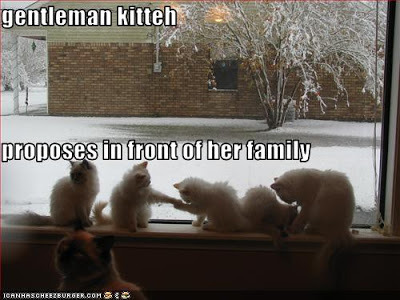 Thanks to Cheezburger.comIn a Georgette Heyer novel, I think it's 'The Grand Sophy' - the heroine decides to throw over convention and take a drive along St James's Streetin her high-perch phaeton. Her relatives were shaken to the core - and the reason for their shock?
Thanks to Cheezburger.comIn a Georgette Heyer novel, I think it's 'The Grand Sophy' - the heroine decides to throw over convention and take a drive along St James's Streetin her high-perch phaeton. Her relatives were shaken to the core - and the reason for their shock?
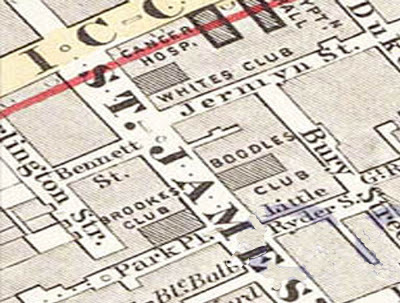 In regency times St James's Street was a male dominion, the home of gentlemen's clubs and shops of masculine interest where a chap could purchase a new gun, buy his cigars or the latest shaving soap in peace. Can you imagine that in the 21st century - a whole road given over to gentlemen? The temptation was too much for me and with the pluck of a modern day Sophy, I went for a walk along St James's to see what had become, in particular, of the clubs.
In regency times St James's Street was a male dominion, the home of gentlemen's clubs and shops of masculine interest where a chap could purchase a new gun, buy his cigars or the latest shaving soap in peace. Can you imagine that in the 21st century - a whole road given over to gentlemen? The temptation was too much for me and with the pluck of a modern day Sophy, I went for a walk along St James's to see what had become, in particular, of the clubs.
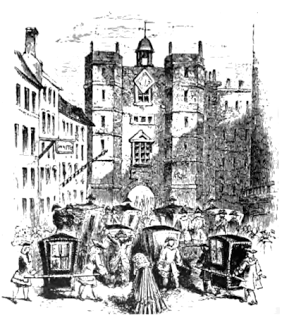 The bottom end of St James's Street - near St James's Palace,
The bottom end of St James's Street - near St James's Palace,
in Georgian times.In the early 19th century a satirical poem published in the Comic Hand observed how on a gentleman split his time between wife, mistress and his club. In the Regency there were three premier clubs: White's, Boodles and Brooks - all situated on St James's Street and providing a private escape in which to gamble. Each club had a distinctive atmosphere and catered for slightly different niches, but each boasted comfy chairs, grand interiors and first-rate service.
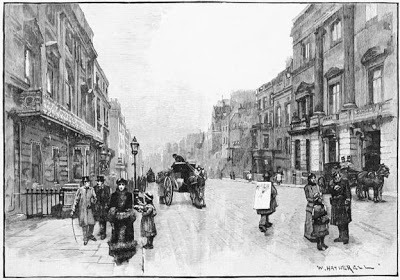 St James's Street in Victorian times -
St James's Street in Victorian times -
Whites' club on the left. In Sophy's day, as she turned off Piccadilly the first gentlemen's club she would pass was White's at number 37. Further down, Boodles at number 28, and on the opposite side of the road, 60 St James's Street, Brooks'.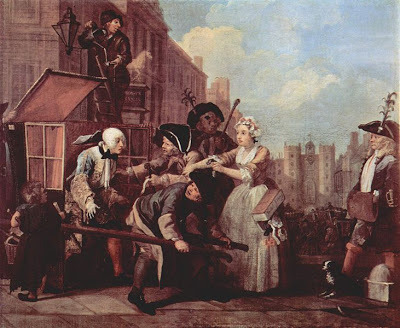 Hogarth's "The Rake's Progress"
Hogarth's "The Rake's Progress"
Set in St James's Street with St James's Palace in the background.
White's was the most exclusive club, so rarified that it was said that on the birth of Horace Walpole's son and heir, the new father despatched his butler to put the child's name down for White's, before even registering the birth. However, the down side of White's were the fortunes wagered at the gaming tables, the club known as 'the bane of English nobility' because of reputations and inheritances lost there.
As Walpolewrote:"In less than two hours, the Duke of Cumberlandlost four hundred and fifty pounds at Loo[a card game]Miss Pelham won three hundred and I, the rest. On another occasion, I lost fifty-six guineas before I could say Ave Maria."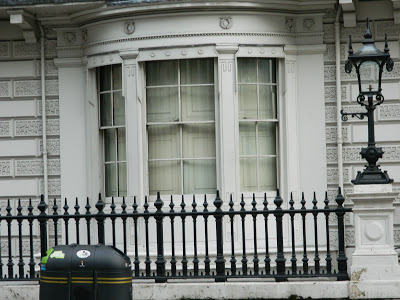 Whites' famous bay window - as it is today.
Whites' famous bay window - as it is today.
It was White's famous bow window that Sophy wanted to see on her drive. The bay was created when the main entrance was moved, and it's view was considered the prime location to see and been seen (even though, according to Beau Brummell's rules, no one sitting in the window should acknowledge a greeting from the street.) Indeed, that arbiter of male fashion, Brummell, adopted the bay as his unofficial state room. When in 1816 gambling debts forced Brummell abroad, Lord Alvanley took the position of honour. Alvanely reputedly bet 3,000 pounds on which of two raindrops would reach the bottom of the bay window first.
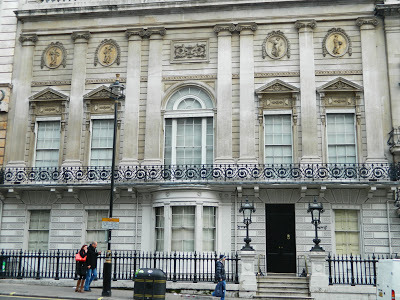 Whites' in the modern day. MP George Selwyn, was a member of White's - his claim to fame is that he was a member of parliament for 44 years and did not once make a speech in the House of Commons.
Whites' in the modern day. MP George Selwyn, was a member of White's - his claim to fame is that he was a member of parliament for 44 years and did not once make a speech in the House of Commons.
In the modern day a former chairman was Ian Cameron, father to the British Prime Minister, David Cameron.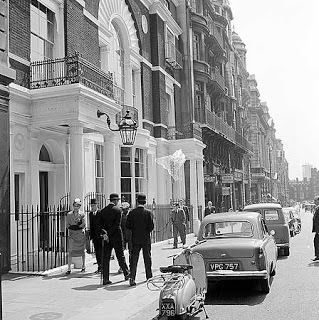 Boodles' Clbu - in the 1960's.
Boodles' Clbu - in the 1960's.
Sophy then passed Boodles , which was the domain of the country set - fans of hunting, shooting and fishing - and of course, gambling. The club was originally called 'Savoir Vivre' but was later renamed after the head waiter, Edward Boodle.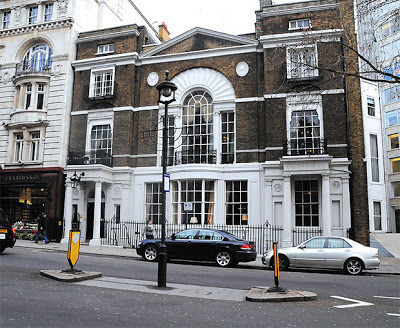 Boodle's as it is today. In modern times - Ian Fleming, author of the James Bond novels was a member.
Boodle's as it is today. In modern times - Ian Fleming, author of the James Bond novels was a member.
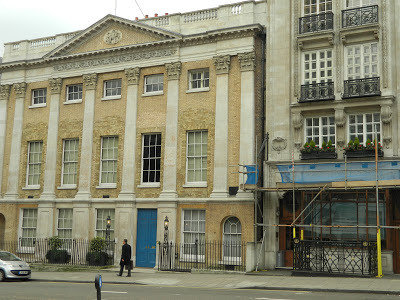 Brooks's in the modern day. Brooks's was the most overtly political club and became the unofficial Whig party headquarters although membership wasn't restricted to politicians. Members included Sir Joshua Reynolds, William Wilberforce and the Prince of Wales. The founder, Brooks, was a wine merchant of whom it was written:
Brooks's in the modern day. Brooks's was the most overtly political club and became the unofficial Whig party headquarters although membership wasn't restricted to politicians. Members included Sir Joshua Reynolds, William Wilberforce and the Prince of Wales. The founder, Brooks, was a wine merchant of whom it was written:
whose speculative skill
In hasty credit and distant bill,
...nursed in clubs, disdain[ed] a vulgar trade,
Exult[ed] to trust, and blush[ed] to be paid
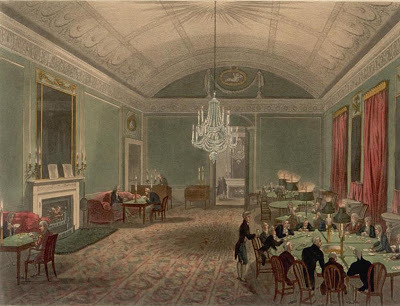 Brooks's gaming room. It seems George Selwyn (see White's Club) wasn't a fan since he described Brooks as:"the completest composition of knave and fool that ever was, to which I may add liar."
Brooks's gaming room. It seems George Selwyn (see White's Club) wasn't a fan since he described Brooks as:"the completest composition of knave and fool that ever was, to which I may add liar."
My walk along modern St James's left me struggling to imagine the former glory of this road. In Sophy's day, from with her view from a high carriage, it must have been a daunting and spectucular sight, but now the car is king, the building looked sad and a little neglected. However, I can report that walking along past the clubs in no way created a scandal - which is a sign of progress....of sorts.
Man is a social animal - Aristotle.
Dr. Johnson on clubs.
 Thanks to Cheezburger.comIn a Georgette Heyer novel, I think it's 'The Grand Sophy' - the heroine decides to throw over convention and take a drive along St James's Streetin her high-perch phaeton. Her relatives were shaken to the core - and the reason for their shock?
Thanks to Cheezburger.comIn a Georgette Heyer novel, I think it's 'The Grand Sophy' - the heroine decides to throw over convention and take a drive along St James's Streetin her high-perch phaeton. Her relatives were shaken to the core - and the reason for their shock?  In regency times St James's Street was a male dominion, the home of gentlemen's clubs and shops of masculine interest where a chap could purchase a new gun, buy his cigars or the latest shaving soap in peace. Can you imagine that in the 21st century - a whole road given over to gentlemen? The temptation was too much for me and with the pluck of a modern day Sophy, I went for a walk along St James's to see what had become, in particular, of the clubs.
In regency times St James's Street was a male dominion, the home of gentlemen's clubs and shops of masculine interest where a chap could purchase a new gun, buy his cigars or the latest shaving soap in peace. Can you imagine that in the 21st century - a whole road given over to gentlemen? The temptation was too much for me and with the pluck of a modern day Sophy, I went for a walk along St James's to see what had become, in particular, of the clubs.  The bottom end of St James's Street - near St James's Palace,
The bottom end of St James's Street - near St James's Palace,in Georgian times.In the early 19th century a satirical poem published in the Comic Hand observed how on a gentleman split his time between wife, mistress and his club. In the Regency there were three premier clubs: White's, Boodles and Brooks - all situated on St James's Street and providing a private escape in which to gamble. Each club had a distinctive atmosphere and catered for slightly different niches, but each boasted comfy chairs, grand interiors and first-rate service.
 St James's Street in Victorian times -
St James's Street in Victorian times - Whites' club on the left. In Sophy's day, as she turned off Piccadilly the first gentlemen's club she would pass was White's at number 37. Further down, Boodles at number 28, and on the opposite side of the road, 60 St James's Street, Brooks'.
 Hogarth's "The Rake's Progress"
Hogarth's "The Rake's Progress" Set in St James's Street with St James's Palace in the background.
White's was the most exclusive club, so rarified that it was said that on the birth of Horace Walpole's son and heir, the new father despatched his butler to put the child's name down for White's, before even registering the birth. However, the down side of White's were the fortunes wagered at the gaming tables, the club known as 'the bane of English nobility' because of reputations and inheritances lost there.
As Walpolewrote:"In less than two hours, the Duke of Cumberlandlost four hundred and fifty pounds at Loo[a card game]Miss Pelham won three hundred and I, the rest. On another occasion, I lost fifty-six guineas before I could say Ave Maria."
 Whites' famous bay window - as it is today.
Whites' famous bay window - as it is today. It was White's famous bow window that Sophy wanted to see on her drive. The bay was created when the main entrance was moved, and it's view was considered the prime location to see and been seen (even though, according to Beau Brummell's rules, no one sitting in the window should acknowledge a greeting from the street.) Indeed, that arbiter of male fashion, Brummell, adopted the bay as his unofficial state room. When in 1816 gambling debts forced Brummell abroad, Lord Alvanley took the position of honour. Alvanely reputedly bet 3,000 pounds on which of two raindrops would reach the bottom of the bay window first.
 Whites' in the modern day. MP George Selwyn, was a member of White's - his claim to fame is that he was a member of parliament for 44 years and did not once make a speech in the House of Commons.
Whites' in the modern day. MP George Selwyn, was a member of White's - his claim to fame is that he was a member of parliament for 44 years and did not once make a speech in the House of Commons. In the modern day a former chairman was Ian Cameron, father to the British Prime Minister, David Cameron.
 Boodles' Clbu - in the 1960's.
Boodles' Clbu - in the 1960's.Sophy then passed Boodles , which was the domain of the country set - fans of hunting, shooting and fishing - and of course, gambling. The club was originally called 'Savoir Vivre' but was later renamed after the head waiter, Edward Boodle.
 Boodle's as it is today. In modern times - Ian Fleming, author of the James Bond novels was a member.
Boodle's as it is today. In modern times - Ian Fleming, author of the James Bond novels was a member.  Brooks's in the modern day. Brooks's was the most overtly political club and became the unofficial Whig party headquarters although membership wasn't restricted to politicians. Members included Sir Joshua Reynolds, William Wilberforce and the Prince of Wales. The founder, Brooks, was a wine merchant of whom it was written:
Brooks's in the modern day. Brooks's was the most overtly political club and became the unofficial Whig party headquarters although membership wasn't restricted to politicians. Members included Sir Joshua Reynolds, William Wilberforce and the Prince of Wales. The founder, Brooks, was a wine merchant of whom it was written:whose speculative skill
In hasty credit and distant bill,
...nursed in clubs, disdain[ed] a vulgar trade,
Exult[ed] to trust, and blush[ed] to be paid
 Brooks's gaming room. It seems George Selwyn (see White's Club) wasn't a fan since he described Brooks as:"the completest composition of knave and fool that ever was, to which I may add liar."
Brooks's gaming room. It seems George Selwyn (see White's Club) wasn't a fan since he described Brooks as:"the completest composition of knave and fool that ever was, to which I may add liar."My walk along modern St James's left me struggling to imagine the former glory of this road. In Sophy's day, from with her view from a high carriage, it must have been a daunting and spectucular sight, but now the car is king, the building looked sad and a little neglected. However, I can report that walking along past the clubs in no way created a scandal - which is a sign of progress....of sorts.
Man is a social animal - Aristotle.
Published on December 19, 2012 04:13
December 12, 2012
Christmas Stockings - a History.
Where did the tradition of hanging out Christmas stockings come from?
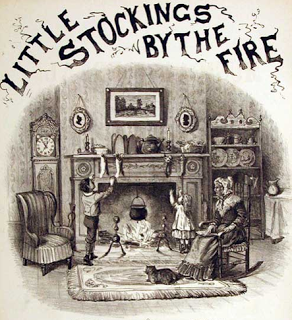 As a child, I remember the magic of on Christmas Eve, being given a pillow case to put at the bottom of the bed. Between getting up to look through the window for Santa's sleigh , and then crawling to the bottom of the bed to see if he'd called already, sleep was an elusive thing - but all part of the excitement of Christmas.
As a child, I remember the magic of on Christmas Eve, being given a pillow case to put at the bottom of the bed. Between getting up to look through the window for Santa's sleigh , and then crawling to the bottom of the bed to see if he'd called already, sleep was an elusive thing - but all part of the excitement of Christmas.
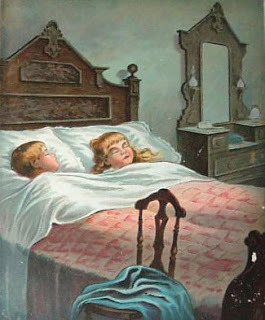 For many children having a pillow case or Christmas stocking waiting to be filled with presents is all part of family tradition - but have you ever stopped to wonder how this slightly odd activity originated?
For many children having a pillow case or Christmas stocking waiting to be filled with presents is all part of family tradition - but have you ever stopped to wonder how this slightly odd activity originated?
"They [Christmas stockings] had to hold candy enough to make the child sick, and toys enough to make him unhappy because he did not know which to play with first." Susan Warner, The Christmas Stocking - a novel. 1854.
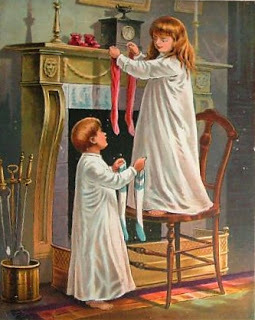 In fact, historians are unclear about exactly when and where the tradition started. Perhaps the earliest origin is a 4th century story about a nobleman who spent all his money providing food for his three daughters during a time of famine. This kind-hearted man even sold his land and moved into a small cottage, using the money to buy bread for the local villagers. On a trip to market his three daughters met and fell in love with three handsome men, but they were unable to marry unless they had handsome dowries. The plight of the impoverished noble man reached the ears of a travelling preacher, Saint Nicholas, and the story goes that Nicholas knew the good man would be too proud to accept charity, so he waited until the household slept, crept in and filled the daughters stockings with gold coins as they hung up to dry by the fire…providing a dowry and a happy ending.
In fact, historians are unclear about exactly when and where the tradition started. Perhaps the earliest origin is a 4th century story about a nobleman who spent all his money providing food for his three daughters during a time of famine. This kind-hearted man even sold his land and moved into a small cottage, using the money to buy bread for the local villagers. On a trip to market his three daughters met and fell in love with three handsome men, but they were unable to marry unless they had handsome dowries. The plight of the impoverished noble man reached the ears of a travelling preacher, Saint Nicholas, and the story goes that Nicholas knew the good man would be too proud to accept charity, so he waited until the household slept, crept in and filled the daughters stockings with gold coins as they hung up to dry by the fire…providing a dowry and a happy ending.
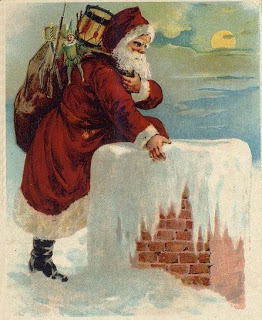
Slightly later stories start to emerge of a Germanic/ Scandinavian figure, Odin, and how children left carrots or straw in their shoes, to feed Odin's magical flying horse. By 16th century Holland, there are written records of children putting wooden clogs by the fire, filled with hay to provide refreshment for Sinterklass reindeer on Christmas Eve. In the morning they rose to find the favour returned and Sinterklass had left small presents in place of the hay. This tradition went through a bit of a lull until the advent of stories of Santa Claus leaving presents for children resurfaced in the mid 19th century.
"On Christmas Eve, each child hangs up one of its stockings in a place where it can easily be reached, in order that Santa Claus may come into the bedroom during the night and deposit some little present in it. And when the child wakens in the morning, sure as fate, in the stocking is a Christmas pie…cut and baked in the shape of a little baby, with currants for eyes…an orange, a ball …or some other article brought by a nocturnal visitor." Victorian account of Christmas Eve in County Durham.
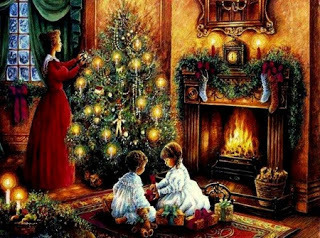 The idea of Santa Claus bringing presents came to England from America around 1865 - 1870, but accounts of children hanging out stockings pre-date this. Perhaps two traditions melded into one because by 1898 the habit was common place.
The idea of Santa Claus bringing presents came to England from America around 1865 - 1870, but accounts of children hanging out stockings pre-date this. Perhaps two traditions melded into one because by 1898 the habit was common place.
"By and by the younger ones are packed off to bed, and with us, as the world over; their stockings are hung at the bed-foot to await the mysterious visit of Santa Claus."1898, Richard Blakeborough writing about a Yorkshire Christmas.
Just bear in mind, that this was provisional on good behaviour. Badly behaved children might well find not presents, but a lump of coal at the bottom of their stockings….
 FOLLOW THE RAFFLECOPTER LINK BELOW - TO ENTER THE PRIZE DRAW FOR A $50 VOUCHER. a Rafflecopter giveaway
FOLLOW THE RAFFLECOPTER LINK BELOW - TO ENTER THE PRIZE DRAW FOR A $50 VOUCHER. a Rafflecopter giveaway
To find the other participating blogs follow this link"
http://terriglong.com/blog/2012/12/meet-the-family-blog-hop-welcome/
Thank you!

 As a child, I remember the magic of on Christmas Eve, being given a pillow case to put at the bottom of the bed. Between getting up to look through the window for Santa's sleigh , and then crawling to the bottom of the bed to see if he'd called already, sleep was an elusive thing - but all part of the excitement of Christmas.
As a child, I remember the magic of on Christmas Eve, being given a pillow case to put at the bottom of the bed. Between getting up to look through the window for Santa's sleigh , and then crawling to the bottom of the bed to see if he'd called already, sleep was an elusive thing - but all part of the excitement of Christmas.  For many children having a pillow case or Christmas stocking waiting to be filled with presents is all part of family tradition - but have you ever stopped to wonder how this slightly odd activity originated?
For many children having a pillow case or Christmas stocking waiting to be filled with presents is all part of family tradition - but have you ever stopped to wonder how this slightly odd activity originated? "They [Christmas stockings] had to hold candy enough to make the child sick, and toys enough to make him unhappy because he did not know which to play with first." Susan Warner, The Christmas Stocking - a novel. 1854.
 In fact, historians are unclear about exactly when and where the tradition started. Perhaps the earliest origin is a 4th century story about a nobleman who spent all his money providing food for his three daughters during a time of famine. This kind-hearted man even sold his land and moved into a small cottage, using the money to buy bread for the local villagers. On a trip to market his three daughters met and fell in love with three handsome men, but they were unable to marry unless they had handsome dowries. The plight of the impoverished noble man reached the ears of a travelling preacher, Saint Nicholas, and the story goes that Nicholas knew the good man would be too proud to accept charity, so he waited until the household slept, crept in and filled the daughters stockings with gold coins as they hung up to dry by the fire…providing a dowry and a happy ending.
In fact, historians are unclear about exactly when and where the tradition started. Perhaps the earliest origin is a 4th century story about a nobleman who spent all his money providing food for his three daughters during a time of famine. This kind-hearted man even sold his land and moved into a small cottage, using the money to buy bread for the local villagers. On a trip to market his three daughters met and fell in love with three handsome men, but they were unable to marry unless they had handsome dowries. The plight of the impoverished noble man reached the ears of a travelling preacher, Saint Nicholas, and the story goes that Nicholas knew the good man would be too proud to accept charity, so he waited until the household slept, crept in and filled the daughters stockings with gold coins as they hung up to dry by the fire…providing a dowry and a happy ending. 
Slightly later stories start to emerge of a Germanic/ Scandinavian figure, Odin, and how children left carrots or straw in their shoes, to feed Odin's magical flying horse. By 16th century Holland, there are written records of children putting wooden clogs by the fire, filled with hay to provide refreshment for Sinterklass reindeer on Christmas Eve. In the morning they rose to find the favour returned and Sinterklass had left small presents in place of the hay. This tradition went through a bit of a lull until the advent of stories of Santa Claus leaving presents for children resurfaced in the mid 19th century.
"On Christmas Eve, each child hangs up one of its stockings in a place where it can easily be reached, in order that Santa Claus may come into the bedroom during the night and deposit some little present in it. And when the child wakens in the morning, sure as fate, in the stocking is a Christmas pie…cut and baked in the shape of a little baby, with currants for eyes…an orange, a ball …or some other article brought by a nocturnal visitor." Victorian account of Christmas Eve in County Durham.
 The idea of Santa Claus bringing presents came to England from America around 1865 - 1870, but accounts of children hanging out stockings pre-date this. Perhaps two traditions melded into one because by 1898 the habit was common place.
The idea of Santa Claus bringing presents came to England from America around 1865 - 1870, but accounts of children hanging out stockings pre-date this. Perhaps two traditions melded into one because by 1898 the habit was common place. "By and by the younger ones are packed off to bed, and with us, as the world over; their stockings are hung at the bed-foot to await the mysterious visit of Santa Claus."1898, Richard Blakeborough writing about a Yorkshire Christmas.
Just bear in mind, that this was provisional on good behaviour. Badly behaved children might well find not presents, but a lump of coal at the bottom of their stockings….
 FOLLOW THE RAFFLECOPTER LINK BELOW - TO ENTER THE PRIZE DRAW FOR A $50 VOUCHER. a Rafflecopter giveaway
FOLLOW THE RAFFLECOPTER LINK BELOW - TO ENTER THE PRIZE DRAW FOR A $50 VOUCHER. a Rafflecopter giveawayTo find the other participating blogs follow this link"
http://terriglong.com/blog/2012/12/meet-the-family-blog-hop-welcome/
Thank you!
Published on December 12, 2012 01:08
December 5, 2012
Unofficial London - Step Back in Time.
Of these wonderful old shops, which is the cuckoo in the nest?

Last Saturday I visited St James's Street and Piccadilly, London, to research gentleman's clubs (but that's another story and another blog post!). I was delighted to find some wonderful old shops that appeared as they might have done when Beau Brummell strutted down St James's or Oscar Wilde went to buy cigarettes. An added bonus were the lovely Christmas displays - so as I'm getting into the festive spirit I've posted some photos and a little trivia associated with each shop. But which shop is fake and only pretending to be old…read on for the answer!
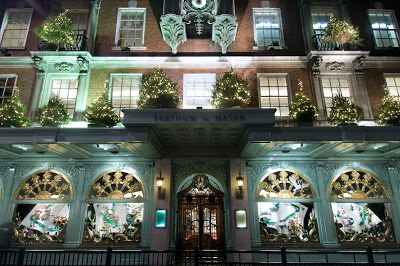 Fortnum and Mason - this photo courtesy of Andrew Marriott.Fortnum and Mason.
Fortnum and Mason - this photo courtesy of Andrew Marriott.Fortnum and Mason.The Fortnums were originally high-class builders who moved to London after the Great Fire, to cash in on the capitals reconstruction. William Fortnum became a footman to Queen Anne. William had the idea of collecting the royal households waste candle stubs and melting them down to make new candles, which he then sold to Hugh Mason who in 1705 had opened a small shop in St James's market.
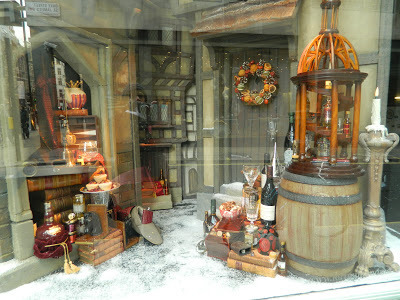 Fortnum and Mason - Christmas window display 2012.Over the centuries Fortnum and Masons have continued that tradition of entrepreneurship. From 1795 to 1839 they offered their own postal service, with collections made six times a day. At the Great Exhibition of 1851, Fortnum's won first prize as importers of dried fruit (incidentally, they also supplied dried fruit to the troops at the Battle of Waterloo, 1815) And when Queen Victoria wanted to send strong beef tea to servicemen tended by Florence Nightingale during the Crimean War, it was Fortnum and Masons she turned to.
Fortnum and Mason - Christmas window display 2012.Over the centuries Fortnum and Masons have continued that tradition of entrepreneurship. From 1795 to 1839 they offered their own postal service, with collections made six times a day. At the Great Exhibition of 1851, Fortnum's won first prize as importers of dried fruit (incidentally, they also supplied dried fruit to the troops at the Battle of Waterloo, 1815) And when Queen Victoria wanted to send strong beef tea to servicemen tended by Florence Nightingale during the Crimean War, it was Fortnum and Masons she turned to. 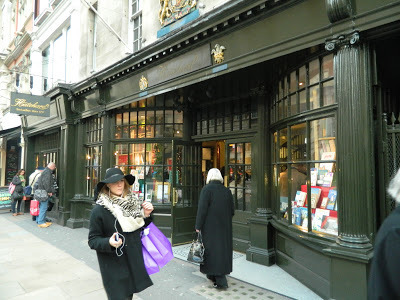 Hatchards - 2012. Hatchard's.Also just around the corner from St James's Street, on Piccadilly, is Britain's oldest surviving bookshop. Since 1797 the current site has been occupied by a bookseller, pioneered by John Hatchard.
Hatchards - 2012. Hatchard's.Also just around the corner from St James's Street, on Piccadilly, is Britain's oldest surviving bookshop. Since 1797 the current site has been occupied by a bookseller, pioneered by John Hatchard.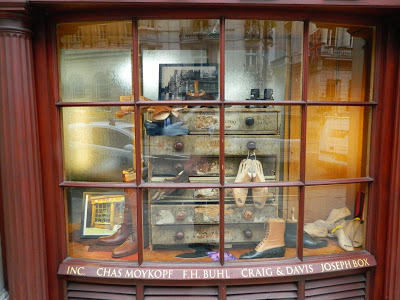 Lobbs window - 2012 Lobbs.Lobbs was founded in 1829, and the original John Lobb was a lame farm hand, whose skill with the last and awl won him awards and brought him to the attention of royalty. His shop was established at 9 St James's Street, on site of Lord Byron's bachelor pad, and to this day still sells traditional hand crafted boots
Lobbs window - 2012 Lobbs.Lobbs was founded in 1829, and the original John Lobb was a lame farm hand, whose skill with the last and awl won him awards and brought him to the attention of royalty. His shop was established at 9 St James's Street, on site of Lord Byron's bachelor pad, and to this day still sells traditional hand crafted boots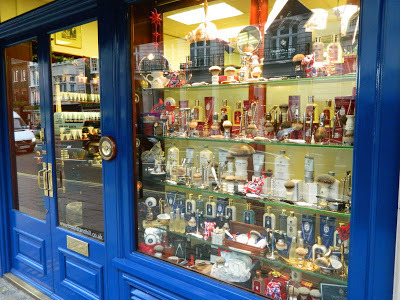 Truefitt and Hill - 2012 Truefitt and Hill
Truefitt and Hill - 2012 Truefitt and HillWilliam Francis Truefitt first sold gentlemen's grooming products in 1705. Just six years later he had established himself as "Court hair cutter" and "Court head dresser", and along with his brother Peter, later went on to became Wigmaker to King George III.
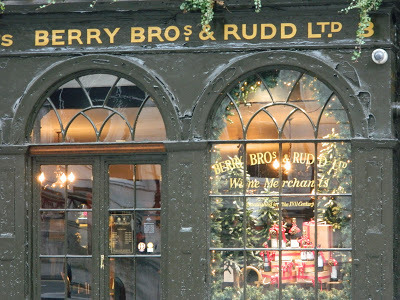 Berry Bros and Rudd - 2012. Berry Bros and Rudd
Berry Bros and Rudd - 2012. Berry Bros and RuddAnother business with links to George III is Berry Brothers and Rudd. Being close to St James's Palace, no doubt their attractive window displays of exotic goods such as tea, coffee, cocoa, spices and snuff, soon attracted royal attention.
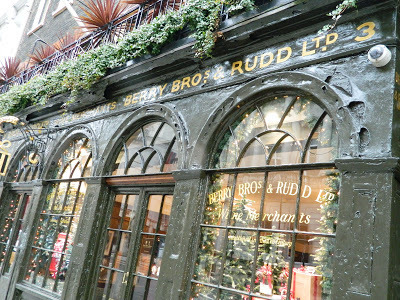 They were established in 1698, and still trade from their original site, 3 St James's Street, London. Today they are principally known as fine wine and spirit merchants, and in 1994 were the first wine retailer to open an online shop.
They were established in 1698, and still trade from their original site, 3 St James's Street, London. Today they are principally known as fine wine and spirit merchants, and in 1994 were the first wine retailer to open an online shop.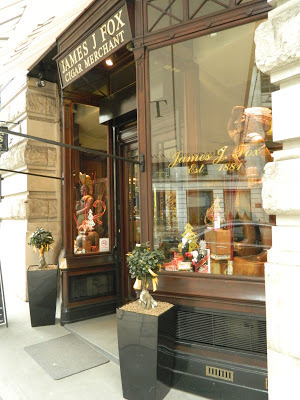 James J Fox -2102 James J Fox - cigar merchant
James J Fox -2102 James J Fox - cigar merchantThis is the world's oldest cigar merchant - so old that they there is a museum in the basement! They first started retailing cigars in 1787, although the Fox family wasn't involved until 1881 when the great great grandfather of the current owner opened a retail shop. Customers have included Winston Churchill, who bought his cigars here, and Oscar Wilder, who defaulted on his bill of 37 pounds, for gold tipped cigarettes of which he reputedly smoked 100 a day.
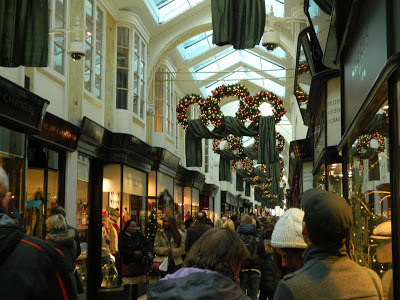 Burlington Arcade - 2012 Burlington Arcade - No post on Victorian shopping would be complete without a mention of the Burlington Arcade. The arcade was built to stop litter and dead cats being tossed over Lord Burlington's garden wall - (for more see a previous post here: http://graceelliot-author.blogspot.co.uk/2012/08/dead-cats-and-commercialism-london.html )
Burlington Arcade - 2012 Burlington Arcade - No post on Victorian shopping would be complete without a mention of the Burlington Arcade. The arcade was built to stop litter and dead cats being tossed over Lord Burlington's garden wall - (for more see a previous post here: http://graceelliot-author.blogspot.co.uk/2012/08/dead-cats-and-commercialism-london.html )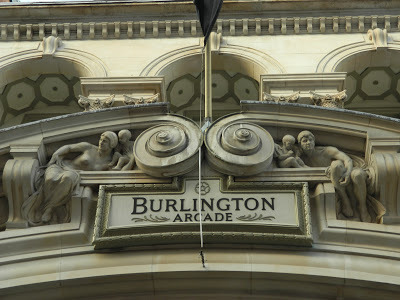
And the cuckoo?Did you guess?
The answer is: Truefitt and Hill - because although the business dates back to Georgian times, this shop was only established in 1994 and merely looks old, as opposed to the other premises which really are old!
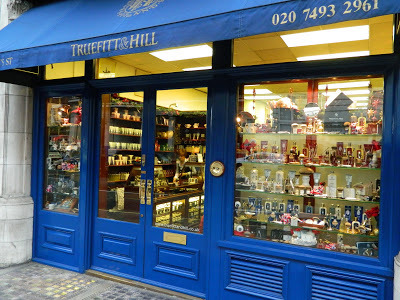 The contents may have its roots in Georgian times
The contents may have its roots in Georgian timesbut this shop was established in 1994.Well done for making it this far!
Before you go, two things.
Firstly, HOPE'S BETRAYAL' is FREE 5 - 9th December inclusive (Amazon)
and
secondly, why not sign up for my newsletter (every 2 months) with news of new releases, special promotions et.c? Just fill in the form here:
http://eepurl.com/r4R3v
Thank you!
Published on December 05, 2012 03:33
November 30, 2012
Is "Happy Ever After" Just a Fairy Tale?
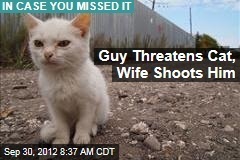 Win a $10 Amazon voucher.
Win a $10 Amazon voucher.To enter see the flash at the end of this post.Romance readers expect a 'happy ever after' ending - but is this just a fairy tale?
Whilst doing research for my historical romances, it is amazing how the truth can be stranger than fiction. In the past, when couples married if their dreams didn't come true and a husband tired of his wife, it seems selling the spouse was an acceptable means of disposing of her. If this theme seems familiar, it may be because Thomas Hardy used the subject of wife-selling in his novel, The Mayor of Casterbridge.
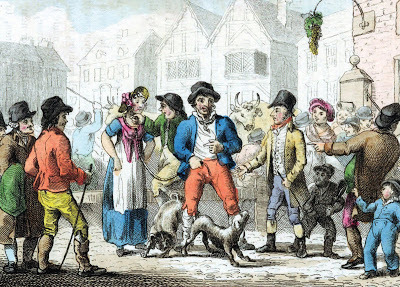 Wife-selling on market day.Since a wife was legally her husband's property and there were no laws against selling a spouse, it seems it was not an unusual occurrence.
Wife-selling on market day.Since a wife was legally her husband's property and there were no laws against selling a spouse, it seems it was not an unusual occurrence. The toll book of the Bell Inn, Birmingham records such a sale:
‘Samuel Whitehouse….this day sold his wife, Mary Whitehouse, in the open market to Thomas Griffiths…value 1 shilling. Taken with all her faults.’
31st August 1773 It was even noted with alarm (or sarcasm?) in the Times on 22nd July 1797:
‘The increasing value of the fair sex is esteemed by several eminent writers to the certain criterion of increasing civilization…and refined improvement as the price of wives has risen at that market [Smithfield]from half a guinea to three guineas and a half [GBP 294 today!].’
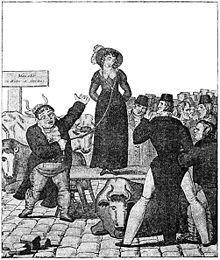
Indeed, another example was the clergyman, Thomas Snowdell, who married during the brief reign of King Edward VI (Henry VIII's son). When Edward died and his half-sister Mary took the throne, Queen Mary changed the law such that married clerics faced a choice between giving up their living…or their wife. The Rev. Snowdell decided his stipend was the more important of the two options and sold his wife to the local butcher!
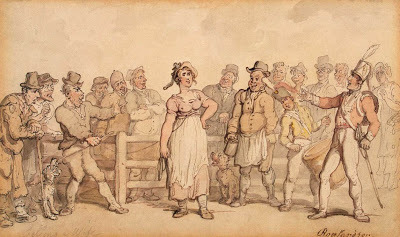 Contempary drawing by Thomas Rowlandson. However some husbands were a little too honest when selling their wives, as with farmer Joseph Thomson and his spouse of 3 years. He offered her for auction in Carlisle, listing her bad points as
Contempary drawing by Thomas Rowlandson. However some husbands were a little too honest when selling their wives, as with farmer Joseph Thomson and his spouse of 3 years. He offered her for auction in Carlisle, listing her bad points as ‘Born serpent’ and ‘his tormentor.’
Amongst her better features he lists;
‘She can read novels, milk cows, makes butter and scold the maid…she is a good judge of the quality of rum, gin or whisky from long experience of tasting it.’
Thomson wanted 50 shillings (GBP 160 today) but accepted the knock down price of 20 shillings and a Newfoundlanddog, which all parties were happy with!
We all know marriage is no fairy tale (except in romantic fiction J)but really, part- exchanging a wife for a dog - whatever next?
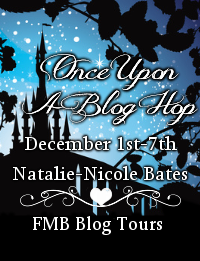
If you have enjoyed this blog post, and to enter the prize draw for a $10 Amazon voucher (or UK equivalent) simply register for Grace's newsletter (every 2 months) using the link below:
You will also be entered in the draw for the FMB Blog Hop overall GRAND PRIZE of a $100 Amazon voucher!
http://eepurl.com/r4R3vBy subscribing you are automatically entered in the draw.
Good luck!
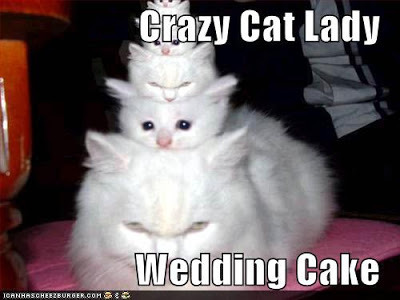 With thanks to Cheezburger.com
With thanks to Cheezburger.com
Published on November 30, 2012 15:10
November 28, 2012
Unofficial London - Goings-On in Fleet Street.
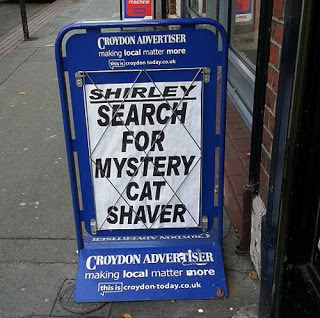 Q. What links Fleet Street to traditional tiered wedding cakes? A. St Bride's church (read on for more!) Today's post is about some of the history of Fleet Street, a name synonymous (until the 1980's at least) as home of the British newspaper industry. The name originates from the River Fleet, which is London's largest underground river.
Q. What links Fleet Street to traditional tiered wedding cakes? A. St Bride's church (read on for more!) Today's post is about some of the history of Fleet Street, a name synonymous (until the 1980's at least) as home of the British newspaper industry. The name originates from the River Fleet, which is London's largest underground river.
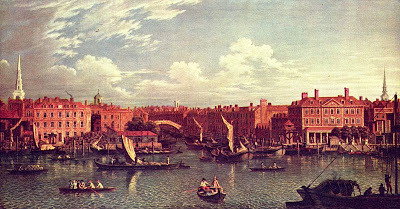 The entrance to the River Fleet in 1750.Perhaps Fleet Street's most notorious resident was Sweeney Todd - the so-called "Demon Barber of Fleet Street". Todd was reputed to have cut the throats of his clients, stolen their valuables and then disposed of their bodies in pies baked by the enterprising Mrs Lovett. However, despite references to Tod starting in the mid-19th century, there seems no factual basis for his story, indeed there is no Sweeney Todd mentioned in contemporary popular press, listed in the register of the Barbers' Company or in the Old Bailey's records.
The entrance to the River Fleet in 1750.Perhaps Fleet Street's most notorious resident was Sweeney Todd - the so-called "Demon Barber of Fleet Street". Todd was reputed to have cut the throats of his clients, stolen their valuables and then disposed of their bodies in pies baked by the enterprising Mrs Lovett. However, despite references to Tod starting in the mid-19th century, there seems no factual basis for his story, indeed there is no Sweeney Todd mentioned in contemporary popular press, listed in the register of the Barbers' Company or in the Old Bailey's records.
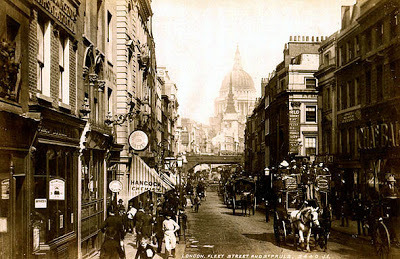 Fleet Street in 1890 - note St Pauls in the distance.The exact origins of Todd's gruesome exploits are unclear but it seems likely there were examples of early 'urban myths' circulating in Victorian times, about what happened to country bumpkins who came to London.
Fleet Street in 1890 - note St Pauls in the distance.The exact origins of Todd's gruesome exploits are unclear but it seems likely there were examples of early 'urban myths' circulating in Victorian times, about what happened to country bumpkins who came to London.
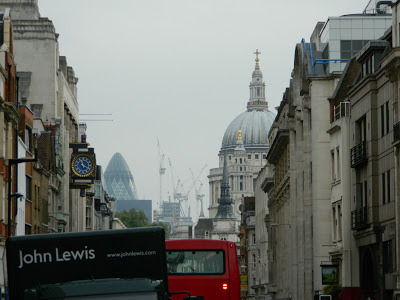 As above on a grey October morning, 2012.Indeed, Charles Dickens alludes to people being made into pies in Martin Chuzzlewit (1844). Here, Tom Pinch gets lost in the evil city:"I don't know what John will think of me. He'll being to be afraid I have strayed into one of those streets where the countrymen are murdered; and that I have been made meat-pies of, or some such horrible thing."Tom's evil genius did not lead him into the dens of any of those preparers of cannibalistic pastry, who are represented in many standard country legends as doing a lively retail business in the Metropolis.
As above on a grey October morning, 2012.Indeed, Charles Dickens alludes to people being made into pies in Martin Chuzzlewit (1844). Here, Tom Pinch gets lost in the evil city:"I don't know what John will think of me. He'll being to be afraid I have strayed into one of those streets where the countrymen are murdered; and that I have been made meat-pies of, or some such horrible thing."Tom's evil genius did not lead him into the dens of any of those preparers of cannibalistic pastry, who are represented in many standard country legends as doing a lively retail business in the Metropolis.Could it be that if Sweeney Todd had not existed, it was necessary to invent him?
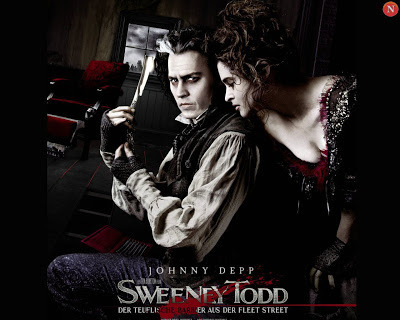 The legend of Sweeney Todd - Tim Burton's interpretation-
The legend of Sweeney Todd - Tim Burton's interpretation-still capturing the imagination today. Whilst on the subject of pies and dining, since the time of the Great Fire of London, Fleet Street was renowned for its taverns and coffeehouses. Tantalisingly, one of these that survives to the present day is Ye Olde Cheshire Cheese (a tavern had been on the same site since 1538) destroyed in the Great Fire and rebuilt in 1667, it is open for business to this day. Charmingly, to the right hand side of the entrance is a list of all the monarchs who have reigned since the Cheese opened its doors.
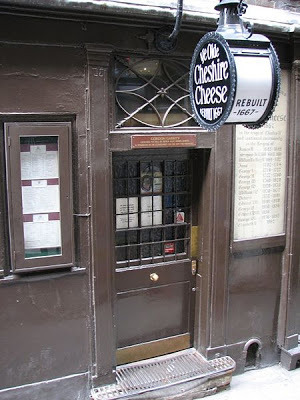 Ye Olde Chesire Cheese -
Ye Olde Chesire Cheese - note to board to the right of the door.And whilst on the subject of food, this brings us back to what links Fleet Street to the traditional tiered wedding cake design.
The answer is St Bride's Church.
Arguably one of the most ancient churches in London thought to be founded by 7th century Celtic monks under the auspices of St Bridget of Ireland. The church has a number of famous parishioners, such as Samuel Pepys, who was baptised here and then in 1644 buried his brother Tom in the vaults- which were reputedly so full that Pepys had to bribe the gravedigger to jostle bodies around to make room.
Destroyed by the Great Fire, Christopher Wren was commissioned to redesign St Bride's and in 1703 work on St Bride's was completed, including a 234 foot spire with four octagonal tiers of diminishing size.
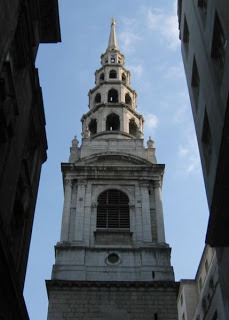 The spire of St Bride's, Fleet Street.Legend has it that an apprentice pastry cook, William Rich, fell in love with his master's daughter. At the end of his apprenticeship Rich set up his own business within sight of St Bride's and gained consent to marry his love. Determined to impress at the wedding breakfast Rich wanted a truly stunning cake and inspired by what he'd seen of St Bride's, created a wedding cake with diminishing tiers…and a tradition was born.
The spire of St Bride's, Fleet Street.Legend has it that an apprentice pastry cook, William Rich, fell in love with his master's daughter. At the end of his apprenticeship Rich set up his own business within sight of St Bride's and gained consent to marry his love. Determined to impress at the wedding breakfast Rich wanted a truly stunning cake and inspired by what he'd seen of St Bride's, created a wedding cake with diminishing tiers…and a tradition was born.
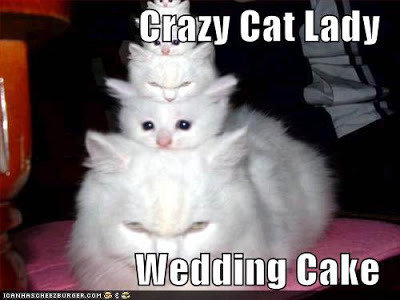 With thanks to Cheezburger.com Thank you for visiting! If you have enjoyed this post and would like an occaisional newletter about Grace Elliot's new releases or special promotions, please follow the link:http://eepurl.com/r4R3vG x
With thanks to Cheezburger.com Thank you for visiting! If you have enjoyed this post and would like an occaisional newletter about Grace Elliot's new releases or special promotions, please follow the link:http://eepurl.com/r4R3vG x
Published on November 28, 2012 01:45
November 21, 2012
Unofficial London - Knightrider Street.
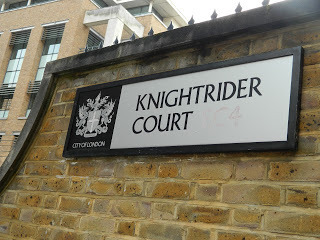
The winning entry in the 2004 'Places on Maps That Relate to David Hasselhoff' competition. Today's blog post considers how medieval Knightrider Street and Knightrider Court,got their names. The etymology of these intriguing streets was mentioned by Stow:
"So called…of Knights well-armed and mounted at the Tower Royal [Towerof London] passing from thence and through that street, west…and hence to Smithfield ….there to turney, joust or to show activities before the King and states of the realm."
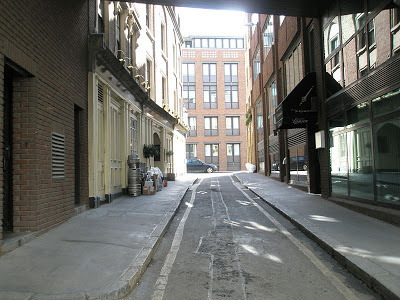 Knightrider Street as it appears today.In other words, this was the route taken by knights on their journey from the Towerof London to Smithfield, to take part in tournaments. The above explanation is doubted by many experts- who fail to offer an alternative explanation!
Knightrider Street as it appears today.In other words, this was the route taken by knights on their journey from the Towerof London to Smithfield, to take part in tournaments. The above explanation is doubted by many experts- who fail to offer an alternative explanation!According to Louis Zetterson in his 1917 book "City Street Names", it certainly seems a street Knyghtriderstrete existed in 1322 but the reason behind the unusual name was already lost even then. Interestingly, on a 1560 map there is a continuation of Knightrider Street, called Giltsword Street and it is hypothesised that this name originated from the golden spurs worn by knights attending the Smithfieldjousts.
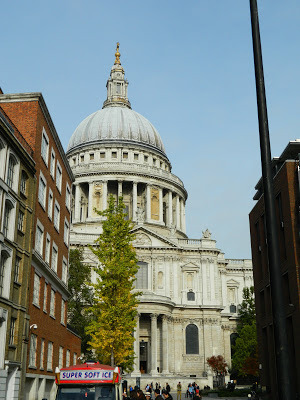 Here I'm standing in Knightrider Court with my back to
Here I'm standing in Knightrider Court with my back to the Thames, facing towards St Pauls Cathedral. Within sight of St Pauls Cathedral is Knightrider Court, and the story goes that as a mark of respect knights were expected to dismount here to proceed on foot past the holy building. Again, the truth behind this myth is lost to us.
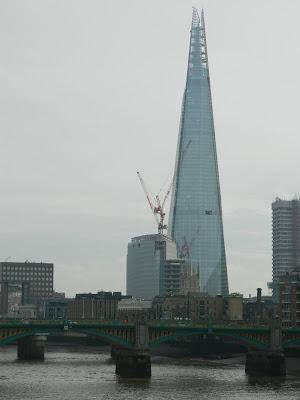 With my back to St Pauls, walking in a straight line from
With my back to St Pauls, walking in a straight line from Knightrider Court, I'm standing on the Millenium Bridge
looking to my left over at The Shard.Staying in the same area, Ben Johnson's London: a Jacobean Place Name Dictionary, by Prof. Chalfont, sites a road near Knightrider Street, charmingly called Do-Little Lane. This thoroughfare once ran north from Knightrider Street to Carter Lane, just off St Pauls - which is today occupied by Knightrider Court and Sermon Lane. Again, Stow describes the street in his commentary:"A place not-inhabited by Artificers, or shop keepers…but serving as a passage from Knightrider Streetto Carter Lane."
Another reference is found in the work of the Jacobean playwright, Middleton, "Family of Love", where a character praises a physician as neither:
"The wise-woman of Pissing Lane, nor she in Do-Little Lane, are as famous for good deeds as he."
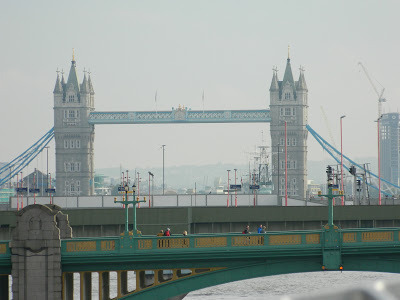 I'm standing in the same spot as the photo above, but looking right instead of
I'm standing in the same spot as the photo above, but looking right instead ofleft, towards Tower Bridge. All of this set me wondering about the origin of Knightsbridge, that exclusive part of London which is home to Harrods, Harvey Nichols and 275 listed buildings. Apparently in medieval times there was indeed a bridge here, over the river Westbourne (which now runs underground) but agreement ends there.
There are two main theories as to how Knightsbridge got its name. The first involves two knights getting into a fight passing over the bridge, falling in the river and drowning, and the second theory is that the area was synonymous with highwaymen and that it was not safe to pass without a knight as chaperone.
Whatever the explanation, is it me or do street names not have the same resonance these days?
 With thanks to Cheezburger.com
With thanks to Cheezburger.com
Published on November 21, 2012 00:21
November 14, 2012
Unofficial London - Then and Now, Pudding Lane.
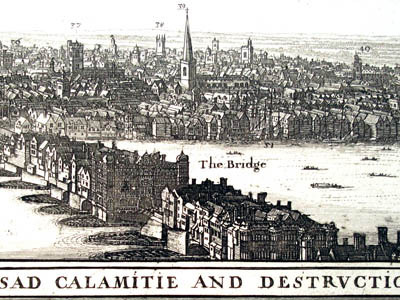 "For years there had been warnings of the total destruction of London by fire." This weeks blog post was inspired by a visit to the where The Great Fire of London started - Pudding Lane - to see how it looks today. But first, a little history...In 1666 the predictions came true and the city of Londonwas devastated by The Great Fire of London. Given the dry summer, close packed timber framed buildings, abundance of hay, and use of candles, this was hardly a surprise. It is now widely acknowledged that the fire started in a bakery in Pudding Lane, but at the time rumours were rife of political intrigue; of the French, or Dutch, or even Catholics setting fire bombs through shop windows to start the conflagration.
"For years there had been warnings of the total destruction of London by fire." This weeks blog post was inspired by a visit to the where The Great Fire of London started - Pudding Lane - to see how it looks today. But first, a little history...In 1666 the predictions came true and the city of Londonwas devastated by The Great Fire of London. Given the dry summer, close packed timber framed buildings, abundance of hay, and use of candles, this was hardly a surprise. It is now widely acknowledged that the fire started in a bakery in Pudding Lane, but at the time rumours were rife of political intrigue; of the French, or Dutch, or even Catholics setting fire bombs through shop windows to start the conflagration.
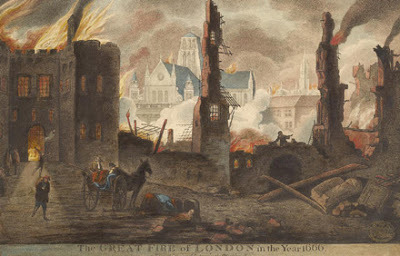
It was at 2am on Sunday 2nd September that a workman at Thomas Faryner's bakery, Pudding Lane, near London Bridge, smelt smoke and woke the household. Modern experiments have shown that under certain conditions fine particles of flour suspended in the air can become explosive, and it seems likely just such a cloud came into contact with an ember and did indeed explode. The fire took rapid hold, jumping from building to building with startling speed. The mayor, Sir Thomas Bloodworth, was woken with the news but remained unimpressed. "A woman might piss it out."
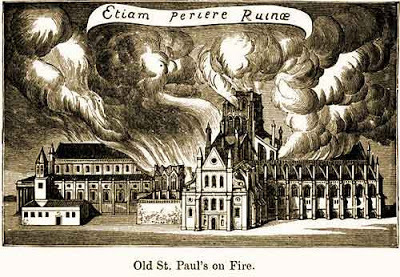 He was wrong. By dawn part of London Bridge was burning and by the time it was exstinguished on Wednesday 5th September, an estimated 13,000 houses and 89 churches, including the Old St Pauls, had been destroyed.
He was wrong. By dawn part of London Bridge was burning and by the time it was exstinguished on Wednesday 5th September, an estimated 13,000 houses and 89 churches, including the Old St Pauls, had been destroyed. 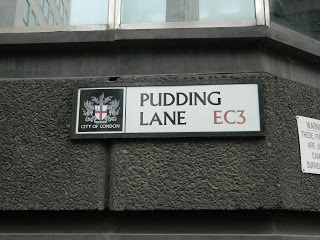
Samuel Pepys records the experience:
.. all over the Thames, with one's face in the wind you were almost burned with a shower of Firedrops - this is very true - so as houses were burned by these drops and flakes of fire, three or four, nay five or six houses, one from another. When we could endure no more upon the water, we to a little alehouse on the Bankside over against the Three Cranes, and there stayed till it was dark almost and saw the fire grow; and as it grow darker, appeared more and more, and, in Corners and upon steeples and between churches and houses, as far as we could see up the hill of the city, in a most horrid malicious bloody flame, not like the fine flame of an ordinary fire.
We stayed till, it being darkish, we saw the fire as only one entire arch of fire from this to the other side of the bridge, and in a bow up the hill, for an arch of above a mile long. It made me weep to see it. The churches, houses, and all on fire and flaming at once, and a horrid noise the flames made, and the cracking of houses at their ruin.
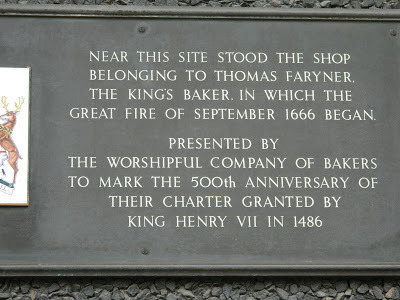
The Great Fire cleared such vaste swathes of buildings that a rebuild of approximately ten million pounds in the 17th century, took place. The fire was commerated by building a monument in 1671, designed by Sir Christopher Wren to mark the regeneration of the city. The Monument was exactly 61 metres tall, which is the distance from the monument to the site of Thomas Faryner's bakery.
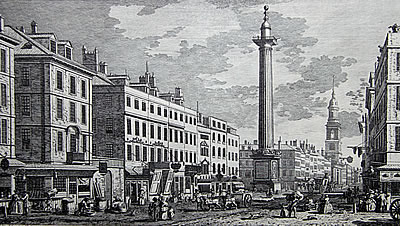 The Monument in 1794.So how does the remodelled city appear today?
The Monument in 1794.So how does the remodelled city appear today?
 The Monument - there....behind the stack of portakabins! And Pudding Lane? Surely some great architectural wonders must celebrate perhaps one of the most well-known streets in London? Sadly not...
The Monument - there....behind the stack of portakabins! And Pudding Lane? Surely some great architectural wonders must celebrate perhaps one of the most well-known streets in London? Sadly not...
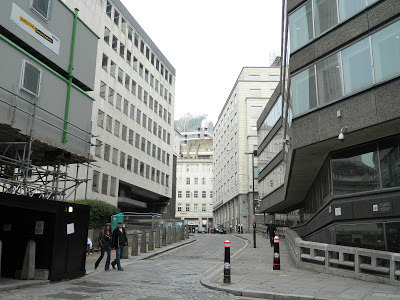 Here, ladies and gentlemen, is modern day Pudding Lane -
Here, ladies and gentlemen, is modern day Pudding Lane -note the portakabins to the left and street sign on the right.
But I won't leave you feeling totally desolate about this wasted opportunity, there is at least is one beautiful building to rise out of the ashes, the new St Pauls Cathedral.
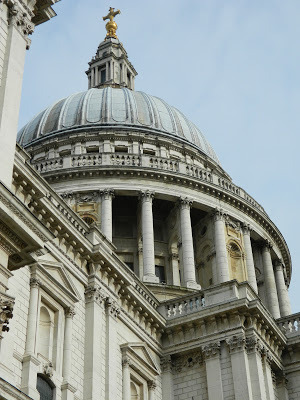
Published on November 14, 2012 00:02
November 7, 2012
Dr Johnson on Cats.
CAT - "a domestick animal that catches mice, commonly reckoned by naturalists the lowest order of the leonine species."
Dr Johnson's definition from the 1755 dictionary.
CAT - "small furry domesticated carnivorous quadruped. A spiteful or malicious woman."Concise Oxford Dictionary 1977.
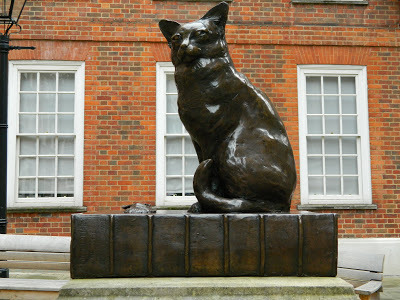 Hodge's memorial - Gough Square.When Dr Johnson wrote that cats were 'commonly reckoned' the lowest feline species, it is my opinion he was being ironic - for the great man was a huge fan of cats. During his life he owned (or 'was owned by'!) several cats, of whom the most well-known was Hodge. In fact, so well-known was Johnson's affection for Hodge that a statue of the cat, appropriately seated on a dictionary, is to be found at the far end of Gough Square.
Hodge's memorial - Gough Square.When Dr Johnson wrote that cats were 'commonly reckoned' the lowest feline species, it is my opinion he was being ironic - for the great man was a huge fan of cats. During his life he owned (or 'was owned by'!) several cats, of whom the most well-known was Hodge. In fact, so well-known was Johnson's affection for Hodge that a statue of the cat, appropriately seated on a dictionary, is to be found at the far end of Gough Square.
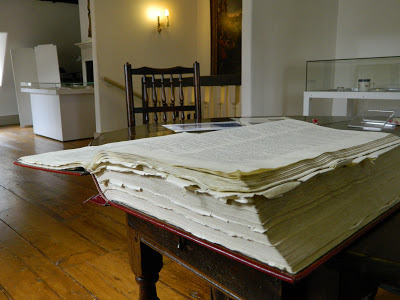 The attic room Johnson worked in (17 Gough Street)
The attic room Johnson worked in (17 Gough Street)
Dr Johnson did most of his work assembling the dictionary, in an attic room at 17 Gough Square. According to his biographer, James Boswell, Johnson was in fact a cat lover.
"Nor would it be just….to omit the fondness which he [Johnson] shewed for animals which he had taken under his protection."
This kindness extended to visiting the fish market in person, in order to select the best oysters for his cat since he didn’t want to put his servants out.
"I never shall forget the indulgence with which he treated Hodge, his cat: for whom he himself used to go out and buy oysters, lest the servants having that trouble should take a dislike to the poor creature."
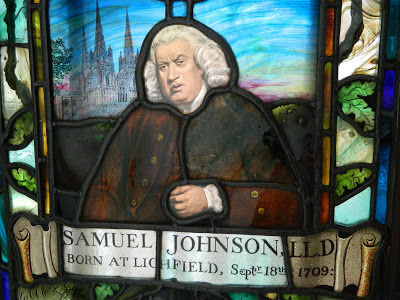 A stained glass window at 17 Gough Street, showing the great man.So did Johnson's partiality for felines colour his dictionary definitions?
A stained glass window at 17 Gough Street, showing the great man.So did Johnson's partiality for felines colour his dictionary definitions?
How do his definitions compare to the modern equivalent?
Let's take a look and find out.
To PURR - "To murmur as a cat or leopard in pleasure." Dr Johnson 1755
PURR - "Make low continuous vibratory sound expressing pleasure."Oxford Dictionary -1977
Hmmm, I prefer Johnson's more poetic version, rather than the more scientific explanation. One, nil to Dr Johnson.
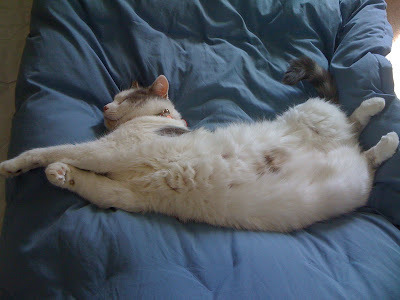 "Purr? That's a tough one. Let me sleep on it." To LAP - "To feed by quick reciprocations of the tongue."Dr Johnson 1755
"Purr? That's a tough one. Let me sleep on it." To LAP - "To feed by quick reciprocations of the tongue."Dr Johnson 1755
LAP - "To take up liquid by the tongue as a cat does." Oxford Dictionary 1977.
Is it just me, or is Johnson's definition more evocative? The Oxforddefinition is very passive, 'taking up liquid' - how exactly is this done?Another vote for Johnson, from me.
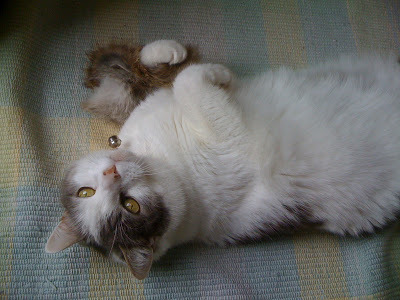 "Mouse, did someone say mouse?"MOUSE - "The smallest of all beasts; a little animal haunting houses and corn fields, destroyed by cats."
"Mouse, did someone say mouse?"MOUSE - "The smallest of all beasts; a little animal haunting houses and corn fields, destroyed by cats."
Dr Johnson 1755
MOUSE - "Small rodent especially shrew or vole: timid, shy or retiring person." Oxford Dictionary 1977
This is one of those answers that have you scurrying around the dictionary. If you aren’t sure what a mouse is then you're probably going to be unclear what a rodent, shrew or vole is….Dr Johnson wins hands down for clarity.
OK, so I might be biased but it seems to me Johnson's almost poetic language when describing cat-related words exemplifies someone who knows, loves and enjoys observing cats.
Bravo, Dr Johnson, Hodge trained you well!


Dr Johnson's definition from the 1755 dictionary.
CAT - "small furry domesticated carnivorous quadruped. A spiteful or malicious woman."Concise Oxford Dictionary 1977.
 Hodge's memorial - Gough Square.When Dr Johnson wrote that cats were 'commonly reckoned' the lowest feline species, it is my opinion he was being ironic - for the great man was a huge fan of cats. During his life he owned (or 'was owned by'!) several cats, of whom the most well-known was Hodge. In fact, so well-known was Johnson's affection for Hodge that a statue of the cat, appropriately seated on a dictionary, is to be found at the far end of Gough Square.
Hodge's memorial - Gough Square.When Dr Johnson wrote that cats were 'commonly reckoned' the lowest feline species, it is my opinion he was being ironic - for the great man was a huge fan of cats. During his life he owned (or 'was owned by'!) several cats, of whom the most well-known was Hodge. In fact, so well-known was Johnson's affection for Hodge that a statue of the cat, appropriately seated on a dictionary, is to be found at the far end of Gough Square. The attic room Johnson worked in (17 Gough Street)
The attic room Johnson worked in (17 Gough Street) Dr Johnson did most of his work assembling the dictionary, in an attic room at 17 Gough Square. According to his biographer, James Boswell, Johnson was in fact a cat lover.
"Nor would it be just….to omit the fondness which he [Johnson] shewed for animals which he had taken under his protection."
This kindness extended to visiting the fish market in person, in order to select the best oysters for his cat since he didn’t want to put his servants out.
"I never shall forget the indulgence with which he treated Hodge, his cat: for whom he himself used to go out and buy oysters, lest the servants having that trouble should take a dislike to the poor creature."
 A stained glass window at 17 Gough Street, showing the great man.So did Johnson's partiality for felines colour his dictionary definitions?
A stained glass window at 17 Gough Street, showing the great man.So did Johnson's partiality for felines colour his dictionary definitions? How do his definitions compare to the modern equivalent?
Let's take a look and find out.
To PURR - "To murmur as a cat or leopard in pleasure." Dr Johnson 1755
PURR - "Make low continuous vibratory sound expressing pleasure."Oxford Dictionary -1977
Hmmm, I prefer Johnson's more poetic version, rather than the more scientific explanation. One, nil to Dr Johnson.
 "Purr? That's a tough one. Let me sleep on it." To LAP - "To feed by quick reciprocations of the tongue."Dr Johnson 1755
"Purr? That's a tough one. Let me sleep on it." To LAP - "To feed by quick reciprocations of the tongue."Dr Johnson 1755LAP - "To take up liquid by the tongue as a cat does." Oxford Dictionary 1977.
Is it just me, or is Johnson's definition more evocative? The Oxforddefinition is very passive, 'taking up liquid' - how exactly is this done?Another vote for Johnson, from me.
 "Mouse, did someone say mouse?"MOUSE - "The smallest of all beasts; a little animal haunting houses and corn fields, destroyed by cats."
"Mouse, did someone say mouse?"MOUSE - "The smallest of all beasts; a little animal haunting houses and corn fields, destroyed by cats." Dr Johnson 1755
MOUSE - "Small rodent especially shrew or vole: timid, shy or retiring person." Oxford Dictionary 1977
This is one of those answers that have you scurrying around the dictionary. If you aren’t sure what a mouse is then you're probably going to be unclear what a rodent, shrew or vole is….Dr Johnson wins hands down for clarity.
OK, so I might be biased but it seems to me Johnson's almost poetic language when describing cat-related words exemplifies someone who knows, loves and enjoys observing cats.
Bravo, Dr Johnson, Hodge trained you well!

Published on November 07, 2012 00:15
October 31, 2012
Halloween - Ghostly Dogs.
 Photo courtesy of www.hawaiikawaii.net As nights draw in, and the autumn air turns thick with bonfire smoke, the stage is set for the arrival of Halloween ghouls and spooks. These conditions would be perfect for Conan Doyle’s phantom dog, the Hound of the Baskervilles, to set about his chilling work of terror. Does it send a shiver down your spine to learn that Conan Doyle based his deadly hound on a dog from British folklore called the ‘Shuck’?
Photo courtesy of www.hawaiikawaii.net As nights draw in, and the autumn air turns thick with bonfire smoke, the stage is set for the arrival of Halloween ghouls and spooks. These conditions would be perfect for Conan Doyle’s phantom dog, the Hound of the Baskervilles, to set about his chilling work of terror. Does it send a shiver down your spine to learn that Conan Doyle based his deadly hound on a dog from British folklore called the ‘Shuck’?From the ‘Black Shuck’ of Orkney to Suffolk and ‘Old Shuck’, stories abound of these ghostly dogs; the size of a Retriever, with blazing eyes. The word ‘Shuck’ is derived from an Old English word ‘Scucca’ meaning a demon, and the Norse believed a dog baying at night was an omen of death.
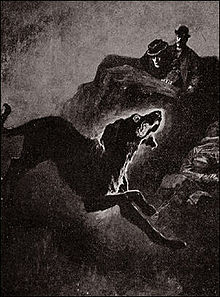 Illustration from Conan Doyle's "Hound of the Baskervilles."Many legends have a 'shuck' dog haunting the gallows as if waiting for a soul to steal. For instance, in 1751 in Tring, Hertfordshire, an old woman was drowned by a chimney sweep because he suspected her to be a witch. He was then found guilty of her murder and sentenced to death by hanging, where upon the gibbet became haunted by a large black dog. The local schoolmaster saw and described it-
Illustration from Conan Doyle's "Hound of the Baskervilles."Many legends have a 'shuck' dog haunting the gallows as if waiting for a soul to steal. For instance, in 1751 in Tring, Hertfordshire, an old woman was drowned by a chimney sweep because he suspected her to be a witch. He was then found guilty of her murder and sentenced to death by hanging, where upon the gibbet became haunted by a large black dog. The local schoolmaster saw and described it-‘Eyes of flaming fire, shaggy… and as big a Newfoundland.’
Part of the horror these legends instilled was the fear of losing your soul. Because people believed that the physical body needed proper burial for the soul to be released, any animal that was seen to eat carrion was labelled as evil.
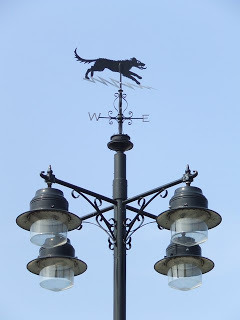 Photo courtesy of Keith Evans.Black Dog ghosts were widespread in the 15thcentury. Warwick Castle was subject to just such an apparition after the Earl of Warwick, antagonised an old woman, Moll Bloxham. She sold butter and milk around the castle precincts but always gave short measures. The locals were too afraid to challenge her, certain she would bewitch them. When the Earl cut off the source of her dairy supplies, Moll swore to haunt him and barricaded herself within the castle tower. Uncertain of how to rid himself of an angry witch the Earl called in three priests. However when they broke down the tower door they found not Moll but a snarling black dog with eyes blazing red and immense fangs. Catching site of the priests the Black Dog jumped from Caesar’s Tower into the river below, and was never seen again.
Photo courtesy of Keith Evans.Black Dog ghosts were widespread in the 15thcentury. Warwick Castle was subject to just such an apparition after the Earl of Warwick, antagonised an old woman, Moll Bloxham. She sold butter and milk around the castle precincts but always gave short measures. The locals were too afraid to challenge her, certain she would bewitch them. When the Earl cut off the source of her dairy supplies, Moll swore to haunt him and barricaded herself within the castle tower. Uncertain of how to rid himself of an angry witch the Earl called in three priests. However when they broke down the tower door they found not Moll but a snarling black dog with eyes blazing red and immense fangs. Catching site of the priests the Black Dog jumped from Caesar’s Tower into the river below, and was never seen again.
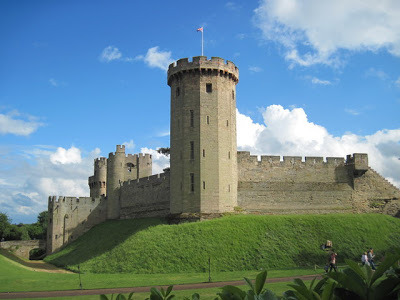 Warwick Castle - photo courtesy of Martin DawesIn the reign of King Charles II a ghostly black dog, the Moddey Dhoo (pronounced ‘Mauther Thoo’ in Manx Gaelic) haunted Peel Castle, the Isle of Man. This large black dog wandered the corridors of the castle at night, to settle himself by the guardroom fire. The soldiers believed him to be an evil spirit waiting for an excuse to harm them and so were respectful in his presence. However one night, a drunken guard mocked them all as cowards and set off to lock the castle gates, passing through the darkened chapel, cursing and swearing as he went. Minutes later his compatriots froze with fear at the blood-curdling sound of screaming. He eventually returned but was unable to speak, his face twisted with fear. He died three days later and the dog was never seen again. Interestingly, in 1871, excavations in the castle found the bones of Simon, the Bishop of Man who died in 1247 and was famous for his intolerance of drunkenness. Buried alongside him at his feet was the skeleton of a dog….
Warwick Castle - photo courtesy of Martin DawesIn the reign of King Charles II a ghostly black dog, the Moddey Dhoo (pronounced ‘Mauther Thoo’ in Manx Gaelic) haunted Peel Castle, the Isle of Man. This large black dog wandered the corridors of the castle at night, to settle himself by the guardroom fire. The soldiers believed him to be an evil spirit waiting for an excuse to harm them and so were respectful in his presence. However one night, a drunken guard mocked them all as cowards and set off to lock the castle gates, passing through the darkened chapel, cursing and swearing as he went. Minutes later his compatriots froze with fear at the blood-curdling sound of screaming. He eventually returned but was unable to speak, his face twisted with fear. He died three days later and the dog was never seen again. Interestingly, in 1871, excavations in the castle found the bones of Simon, the Bishop of Man who died in 1247 and was famous for his intolerance of drunkenness. Buried alongside him at his feet was the skeleton of a dog….
All over Europe tales of spectral hounds exist such as ‘Gabriel’s hounds’ in Britain, the ‘Wild Hunt’ from Germanyand the Scandinavia ‘Woden’s Hunt.’ The latter are hounds that crossed the sky, not dissimilar from the stories of Cherokee Indians - they describe the Milky Way as ‘Where the dog runs.
From Siberiacomes the belief the dogs belonging to the god, Tuli, caused earthquakes. These flea-ridden dogs pulled a sledge through the sky, on which rested the earth. Each time the dogs stopped for a scratch, the earth shook and man was aware of an earthquake.

Certain dogs struck fear into the ancient Chinese who believed they could possess their souls. They distrusted the elderly dogs called ‘jen-shih’ or ‘one who imitates a person.’ It was believed they saw and knew too much, granting them power to possess the living and transform people into vampires.
Finally, some dogs were used to break spells and bring good luck. Dog’s blood poured at the village threshold would protect the inhabitants from evil and be a barrier for epidemics. Three thousand years ago, when a Prince of China undertook a long journey, disturbingly, he would deliberately roll his cart over a dog to crush the poor animal. The blood was said to consecrate the road and the body buried as a sacrifice to the road god for his goodwill. Who knows what ghostly form these sacrificial dogs might then take – the Black Shuck perhaps?
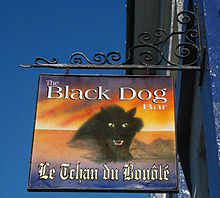 Black dog legends are widespread
Black dog legends are widespread and part of local culture.
Published on October 31, 2012 06:21
October 24, 2012
Halloween - Cats and the Undead.
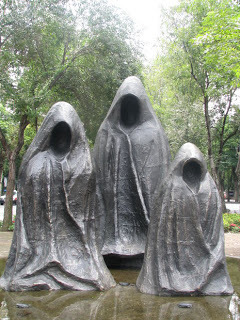
For centuries cats have been linked to the supernatural - and never more so than at Halloween when spirits from the underworld are said to roam the earth. This superstition has its roots in Samhain, a Celtic festival marking the start of winter, when a portal between the spirit and physical worlds briefly opened. The Anglo-Saxons adopted this festival but renamed it 'Halloween', and later the Christian church rebranded it as the eve of All Saints Day. However, folklore in many countries has it that the devil can enter man’s domain throughout the year, using the cat as his agent.
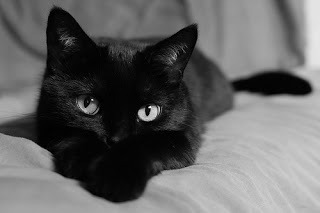 Old English tradition said a cat roaming in a graveyard was in search of a soul to possess and worse still, a cat sitting on a gravestone had claimed the deceased for the devil. Indeed, two cats fighting in a graveyard were interpreted as a battle between an angel and the devil, and in medieval Europeblack cats represented the devil and white, a healer.
Old English tradition said a cat roaming in a graveyard was in search of a soul to possess and worse still, a cat sitting on a gravestone had claimed the deceased for the devil. Indeed, two cats fighting in a graveyard were interpreted as a battle between an angel and the devil, and in medieval Europeblack cats represented the devil and white, a healer. 
During the middle ages in Eastern Europe, it was said that a cat jumping over a corpse transformed the deceased into a vampire, whilst in Northumbriaa cat that walked over a body would be killed, so as to preserve the soul of the departed. Remarkably similar superstitions existed in ancient China. On the death of his owner, a cat would be given away until after the burial. The relatives believed that if the cat leapt over the body, the corpse would rise up and miss its chance of redemption.
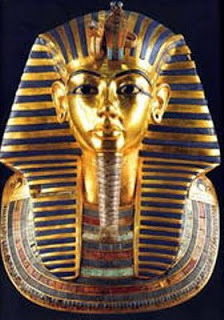
On a more positive note, the Malayan Jakurs held that on their death, a cat would lead them through the fires of hell, spraying as he went to cool the path to heaven. Likewise the Egyptian Pharaoh, Tutankhamen, was led safely to the underworld by a black cat.
A Norse legend, tells that Freya, the goddess of love and fertility, rode in a chariot pulled by two black cats although the latter were actually horses that had been possessed by the devil. The cats served Freya well for seven years, and at the end of this time were rewarded by being turned into witches – disguised as cats.
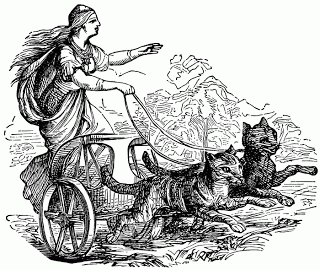 Freya- and her cat drawn chariot.Centuries old insecurities led the cat to be labelled as the witch’s familiar. The Hungarians even specified the age at which this happened and the cat could be spared by incising a crucifix on its skin before it reached seven. Scotlandeven had its own sinister cat, the Cait Sith or Highland Fairy Cat; more demon than fairy, this monstrous black and white animal with a spot on his chest, was said to be a transformed witch.
Freya- and her cat drawn chariot.Centuries old insecurities led the cat to be labelled as the witch’s familiar. The Hungarians even specified the age at which this happened and the cat could be spared by incising a crucifix on its skin before it reached seven. Scotlandeven had its own sinister cat, the Cait Sith or Highland Fairy Cat; more demon than fairy, this monstrous black and white animal with a spot on his chest, was said to be a transformed witch.
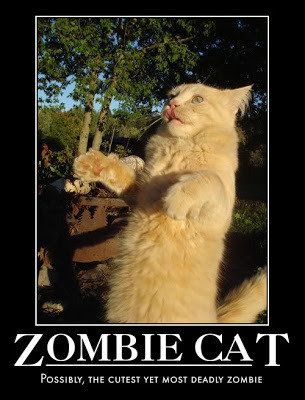
So strong was the association of cats with witchcraft that in 15th century Europe they were synonymous as a symbol of evil. Pope Innocent VIII legalised the persecution of witches, and many women who kept cats were tortured. The hysteria spread, harming women and cats was encouraged in the name of ‘casting out the devil.’ When Elizabeth I came to the throne, some Protestants staged mocking ceremonies of this superstition, by filling a wicker dummy of the Pope with cats, which they threw onto a bonfire. The screams of the cats was said to be,
‘The language of the devil from the body of the Holy Father.’
This sick circle continued with Catholics shaving cats' heads, to represent protestant friars, and then hanging the poor animals.
The Ainu (Aboriginal people of Japan) had a much healthier respect, or even fear, of hurting a cat. Their folklore held that a cat would avenge his death by bewitching the killer, causing him to waste away whilst acting like a cat, and die horribly whilst mewing. The Ainu called this possession ‘Meko Pagoat’ or ‘cat punishment.’
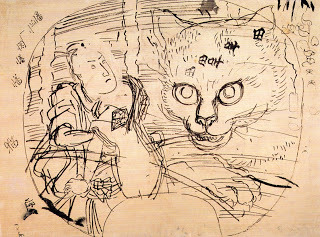 A Japanese ghost cat.The victim could avoid this fate by eating the cat that he had killed. Indeed, it wasn’t too late even if symptoms started to develop, since killing another feline and that one instead could affect a cure!
A Japanese ghost cat.The victim could avoid this fate by eating the cat that he had killed. Indeed, it wasn’t too late even if symptoms started to develop, since killing another feline and that one instead could affect a cure!Consider then the Irish, three hundred years ago, who believed that to kill a cat brought seventeen years bad luck. A man who drowned a cat would himself die by drowning, and a farmer could expect all his cattle to die. Although a broth of boiled cat was said to cure tuberculosis, people were so afraid of the consequences, that they hired professional ‘hit men’ to kill the cat for them and hence take the bad luck.The last word goes to the Cat-Goblins of Provence. These are spirits that after sunset appear as cats with glowing eyes, who like nothing better than to cause mischief to humans. The traveller is advised to cover his own eyes against them, seek the help of the saints and make for a lighted building – an excellent excuse to find the nearest hostelry in which to recover!
Happy Halloween everyone!
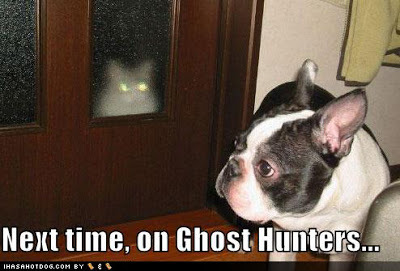
Published on October 24, 2012 02:29
'Familiar Felines.'
Following on from last weeks Halloween posting, today's blog post looks at the unwanted image of cats as the witches familiar - from the Norse Goddess Freya to lonely women in the middle ages.
The full Following on from last weeks Halloween posting, today's blog post looks at the unwanted image of cats as the witches familiar - from the Norse Goddess Freya to lonely women in the middle ages.
The full post can found at:
http://graceelliot-author.blogspot.com
...more
The full Following on from last weeks Halloween posting, today's blog post looks at the unwanted image of cats as the witches familiar - from the Norse Goddess Freya to lonely women in the middle ages.
The full post can found at:
http://graceelliot-author.blogspot.com
...more
- Grace Elliot's profile
- 156 followers



